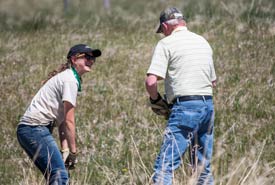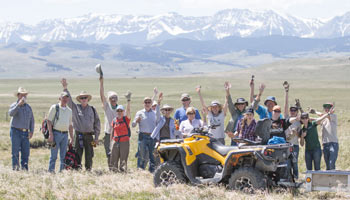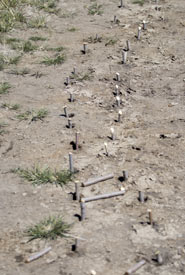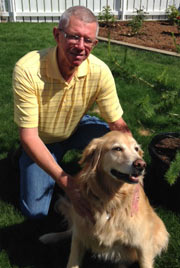Willows on the Waldron

Willows on the Waldron CV event, AB (Photo by NCC)
"Willows on the Waldron," the website read. A volunteer opportunity. Nature Conservancy of Canada. A worthy cause. I think to myself, "Self! here's your chance. Walk the talk! Let's volunteer!”
But Willows…? On the Waldron?
Something doesn't add up here. Conjured childhood memories. Men in kimono robes, sitting cross-legged and weaving willow baskets. And me, cutting grass in the summer in the 1960s, west end Toronto. A next door neighbour's back lawn. Her surname rhymed with twig; her husband's name reminiscent of a famous singing chipmunk. And that darned willow tree... large, limp, sallow, consuming the whole backyard. Golden coloured twigs everywhere on the ground. Branches slapping me in the face. Weak, weeping branches. Recollections of my father frowning at the tree, cursing its roots, claiming them a menace to stormwater systems and sewers. More importantly, he would say, they dull our lawn mower blades -- our only mower, he emphasized to me. “Darn willow tree!” I curse.
Fast forward to present day. Forty plus years later. May 2015, on the Waldron Ranch, a magnificent rolling landscape: wild, crude, untamed cattle country; grasslands and snow-capped mountains on the western wispy clouded horizon. Images of the past, the North-West Mounted Police, cowboys, lawlessness, and whiskey trains and scoundrels.

Group photo, Willows on the Waldron CV event, AB (Photo by NCC)
So, how can the lowly willow tree fit in with the rugged Waldron? The meek versus the strong? I travel from Lethbridge west, and then north on Alberta's famous Cowboy Trail, Highway 22, to find out the how and the why. It's a beautiful day, warm with clear blue skies. I am strangely optimistic about spending the day with staff of the Nature Conservancy of Canada and other unknown people who have volunteered to plant willow “live stakes” (whatever they are) along a targeted dugout on the Waldron Ranch.
Two years ago, the Nature Conservancy of Canada began a campaign to raise funds and finance a conservation easement on land owned by the Waldron Grazing Cooperative. Located in the Foothills Montane sub-region and a large part of the upper Oldman River watershed, the goal was to conserve Canada's only natural and intact western grasslands area. The 54,480-acre (22,050-hectare) expanse is home to a full complement of Great Plains fauna and flora. Wildlife such as elk and grizzly bear, and plant species like the towering rough fescue grasses, among others, are native to the area.

Willow live stakes in the ground, Waldron, AB (Photo by NCC)
We meet at a campground area. Including myself, there are about 12 volunteers and half a dozen NCC staff. We travel in our vehicles across fields to our designated planting spot: a large dugout and outlet stream. By my standards, this seems to be a very large dugout, and soil erosion is evident. The trees we have brought along to plant indeed live stakes, or branches cut from a mature willow tree, devoid of any leaves, about three feet long and tapered at one end. We pound these live stakes, tapered end first, into the wet soil along the perimeter of the dugout. These sticks will develop into mature willows whose roots will work to prevent riparian soil erosion and aid in filtering and cleaning the water in the dugout for the cattle to consume. Willow roots, we also learn, can often grow thicker than the size of the tree trunk. We repeat this exercise on the banks of another small stream, and 600 plantings later, retire for the day. Though tiring work involving a fair amount of hiking in the warm Alberta sunshine, it has been an exhilarating and fun experience.
I have indeed learned a great deal. I am impressed with the knowledge, professionalism and dedication of the NCC staff like Mike Gibeau and the Conservation Volunteer team. I'd like to thank Zoe Arnold for her attention helping me with my special needs. I'm also an admirer of Mike Roberts, range manager of the Waldron. Mike and his cowboys place a high value on the Waldron rangeland health. They go to great lengths to preserve grasses like the rough fescues, sedges and trees for erosion control. Their best practices also include pasture rotation and timing to promote an increase in desirable grass species for their 14,000 cattle head. Proper rotation promotes increased efficiency in fescue grass utilization as fescues retain a higher protein value than Kentucky bluegrass or timothy, and can better withstand drought and the harsh drying winter Chinook winds.
In summary, the Waldron Cooperative uses sustainable management practices and promotes resilience based ecosystem stewardship. By limiting soil erosion, promoting fescue grass and working within the foothills grasslands ecosystem to protect all species, they are enabling the Waldron to absorb disturbance and still maintain its basic structure and function. This wise stewardship, along with their partnership with the Nature Conservancy of Canada, means they are leaving the environment in better shape for future generations than when they took over from their predecessors.
Still, as I drive back home to Lethbridge reminiscing about the day's events, I couldn't get a certain phrase out of my mind: "Darn ******* willows!"


